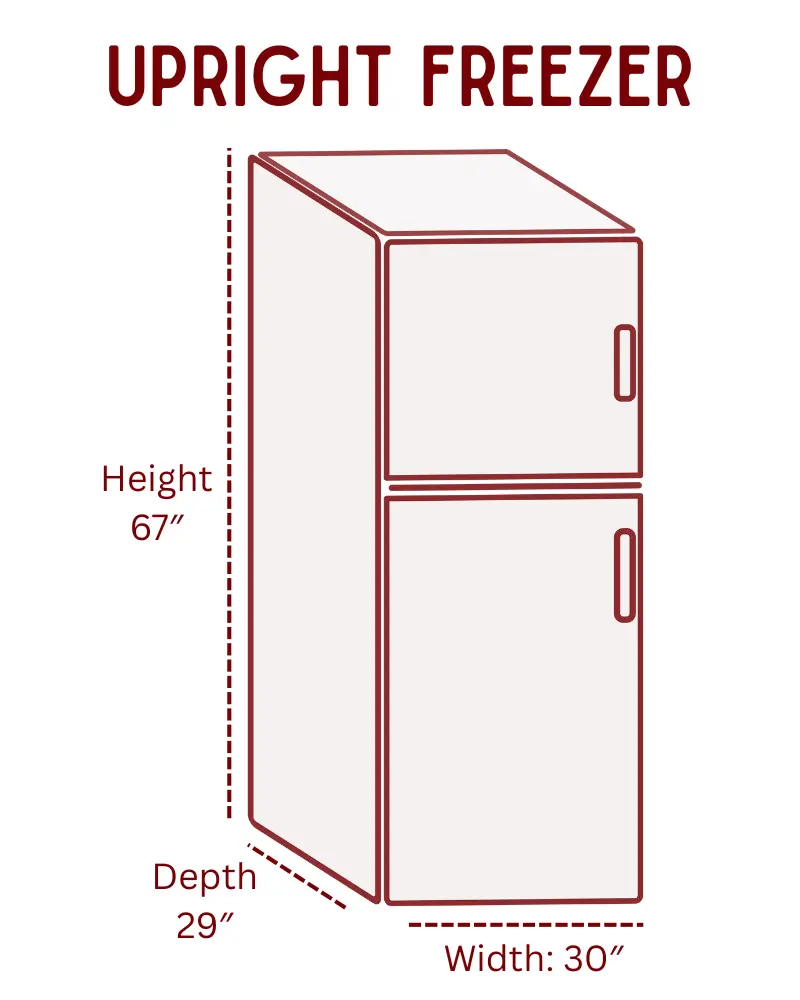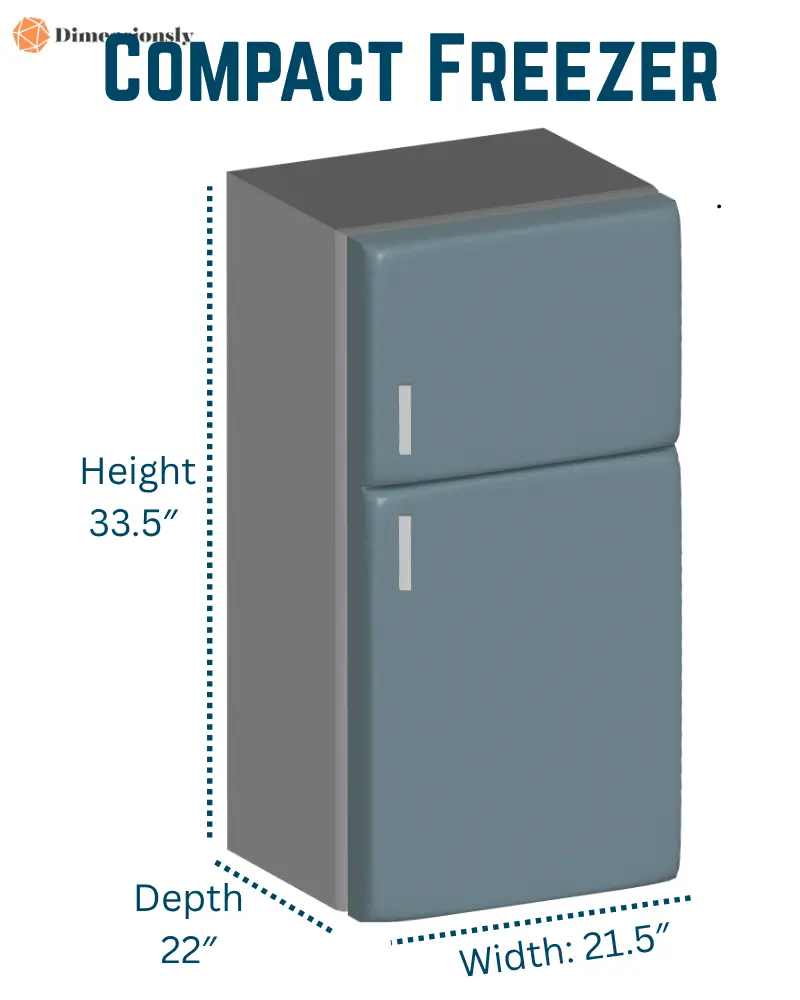Standard freezer dimensions vary by type. Upright freezers typically measure 30″ wide, 29″ deep, and 67″ high. A 15 cu. ft. chest freezer is about 56″ wide, 28″ deep, and 33.5″ high. Compact freezer dimensions average 21.5″ x 22″ x 33.5″. Knowing the exact freezer size helps ensure the right fit for your space.
Standard Freezer Dimensions
| Freezer Type | Width (in / cm) | Depth (in / cm) | Height (in / cm) |
|---|---|---|---|
| Upright Freezer | 30″ / 76 cm | 29″ / 74 cm | 67″ / 170 cm |
| Chest Freezer | 56″ / 142 cm | 28″ / 71 cm | 33.5″ / 85 cm |
| Compact Freezer | 21.5″ / 55 cm | 22″ / 56 cm | 33.5″ / 85 cm |
Standard Freezer Types and Their Dimensions
Freezers come in three main types—upright, chest, and compact—each with typical dimensions that fit different spaces and needs. Upright freezers usually measure about 30″ wide, 29″ deep, and 67″ high. They save floor space and offer easy access but often have less storage and use more energy due to door openings.
Chest freezers tend to be wider and lower, around 56″ wide, 28″ deep, and 33.5″ high for a 15 cu. ft. model. They provide more capacity and better energy efficiency but require more floor space and can be harder to organize.
Compact freezers are small, averaging 21.5″ by 22″ by 33.5″. They fit tight spaces but offer limited storage, making them best for light or secondary use. Choosing the right freezer means balancing size, capacity, and energy use while considering your available space and storage needs. Each type has tradeoffs, so think carefully about what fits your lifestyle best.
Upright Freezers: Tall, Slim, and Space-Efficient
Upright freezers are a popular choice for those who want vertical storage that saves on floor space. Typically, they measure about 30 inches wide, 29 inches deep, and 67 inches high, making them tall and slim. Because of this design, they fit well in kitchens, basements, and garages where floor space is limited.
On the plus side, upright freezers offer easy access with multiple shelves and compartments, allowing you to organize food neatly. Additionally, their vertical shape means you don’t need a large footprint, which is great for smaller rooms.
However, there are tradeoffs. Uprights generally have less overall capacity compared to chest freezers of similar external size. Moreover, they tend to lose cold air each time the door opens, which can lead to higher energy use. This makes balancing convenience and efficiency a key challenge when choosing this style.
Ultimately, it’s important to consider how the freezer’s height and narrow width will impact your available space and energy bills. Choosing an upright freezer means prioritizing vertical storage and easy access, but you may need to compromise on capacity and operating costs.

Chest Freezers: Wide, Deep, and High-Capacity
Known for their spacious interiors and energy efficiency, chest freezers offer bulk storage in a low-profile design. For example, a typical 15 cubic foot chest freezer measures about 56 inches wide, 28 inches deep, and 33.5 inches high. This wide and deep footprint provides ample space for storing large quantities of food.
Chest freezers work best for large families, bulk buyers, and hunters who need to freeze lots of items at once. Because they open from the top, they maintain cold temperatures more effectively, which reduces energy consumption compared to upright models.
However, the tradeoff is their size—chest freezers take up significant floor space, which can be challenging in smaller homes. Also, accessing items at the bottom requires bending down and organizing carefully to avoid losing track of stored goods.
To maximize storage, consider using bins or baskets inside to keep similar items together and improve visibility. This approach helps overcome the challenge of digging through a deep freezer and saves time.
Ultimately, choosing a chest freezer means balancing your need for high capacity and energy savings against the available floor space and ease of access. Understanding these factors will help you pick a model that fits your lifestyle and home layout.

Compact Freezers: Small Footprint, Big Convenience
Compact freezers are the perfect solution for tight spaces, dorm rooms, and apartments. Typically, they measure around 21.5 inches wide, 22 inches deep, and 33.5 inches high, making them easy to fit in small areas where larger models won’t work.
Because of their size, compact freezers are ideal for office break rooms, small kitchens, or as secondary storage units. They provide quick access to frozen essentials without taking up much space.
However, the tradeoff is limited storage capacity, which means they may not meet the needs of larger households or bulk shoppers. Additionally, compact freezers often lack the organizational features found in bigger models, making it harder to keep items sorted.
To overcome these challenges, consider using small bins or labels to maximize space and organization. Also, be mindful of where you place the freezer to ensure proper ventilation despite the confined footprint.
Ultimately, selecting a compact freezer involves balancing the convenience of a small size against the limited capacity and potential organizational hurdles. By weighing these factors carefully, you can find a freezer that fits both your space and lifestyle.

Measuring Your Space: Tips for a Perfect Fit
Before purchasing a freezer, take careful measurements of your available space—and don’t forget clearance for doors and ventilation. Accurate measurements ensure the freezer fits comfortably without blocking walkways or causing overheating.
Start by measuring the width, depth, and height of the area where you plan to place the freezer. Use a tape measure and record the exact numbers. Next, account for extra space needed to open the freezer door fully—this clearance can vary depending on the model’s door swing or lid style.
Additionally, proper ventilation is crucial. Most freezers require several inches of space around the back and sides to allow heat to escape and keep the appliance running efficiently. Failing to provide this can lead to overheating and reduced lifespan.
Don’t forget to check floor support, especially for heavier chest freezers. Make sure the flooring can handle the weight without damage. Finally, confirm that there’s a nearby electrical outlet that can safely supply the freezer’s power needs without causing cord hazards.
Balancing all these factors can be tricky, especially in small or irregular spaces. However, taking the time to measure carefully and consider door clearance, ventilation, floor strength, and outlet placement will save you headaches and costly adjustments later.
In the end, precise measurements and thoughtful planning help ensure you choose a freezer that fits your space perfectly and operates safely and efficiently.
Freezer Capacity vs. Dimensions: What You Need to Know
While external dimensions give you the outer size, the internal capacity (measured in cubic feet) tells you how much food your freezer can actually hold. Understanding this distinction is essential when choosing the right freezer for your needs.
First, cubic feet refer to the usable interior space available for storage, which can differ significantly from the overall size of the freezer. For example, insulation thickness and built-in components can reduce the storage volume even if the freezer looks large on the outside.
Next, when estimating how much food a freezer can store, a general rule of thumb is that one cubic foot accommodates about 35 to 40 pounds of food. However, how you organize the freezer also impacts how efficiently you use this space.
That said, balancing size and efficiency presents challenges. Larger freezers offer more storage but consume more energy, whereas smaller models save space and power but may not meet your capacity needs. Additionally, overly large freezers in small spaces can make access difficult and waste energy if not fully utilized.
Therefore, it’s important to consider not just the freezer’s physical footprint but also how its capacity aligns with your typical food storage habits. Choosing the right balance can help you save energy, optimize space, and avoid unnecessary expenses.
In conclusion, carefully weighing external dimensions against internal capacity ensures you select a freezer that truly fits both your space and your lifestyle.
Choosing the Right Size for Your Needs
Picking the right freezer size depends on your household size, food storage habits, and available space. These factors all play a critical role in finding a model that fits your lifestyle without wasting energy or space.
Firstly, experts recommend allocating about 1 to 2 cubic feet of freezer space per person. For example, a single person might need a compact freezer, while a family of four may require a larger chest or upright freezer. However, these are general guidelines—your actual needs can vary based on how often you buy in bulk or freeze meals.
Next, balancing energy efficiency with capacity is key. Larger freezers store more food but often consume more power, especially if they’re not fully utilized. Conversely, smaller freezers may be more efficient but might force frequent trips to the store or limit bulk buying.
Furthermore, consider future-proofing your purchase. Your household size or storage habits may change over time, so selecting a freezer with a bit of extra capacity can prevent needing a replacement too soon. However, avoid buying oversized units that waste space and energy unnecessarily.
Ultimately, choosing the right freezer size requires weighing your current and future needs against space constraints and energy costs. By carefully considering these tradeoffs, you can make a decision that balances convenience, cost, and sustainability.
Conclusion
Understanding standard freezer dimensions is the first step toward a smart, space-conscious purchase that meets your needs for years to come. By balancing size, capacity, and energy use, you can overcome common challenges and choose a freezer that fits your space, lifestyle, and budget effectively.
FAQs
What freezer size do I need for a family of four?
For a family of four, a freezer with 8 to 10 cubic feet of capacity typically works well. This size balances enough storage for bulk groceries and meal prep without wasting space or energy.
How much clearance should I leave around my freezer?
Allow at least 2 to 3 inches of clearance on all sides for proper ventilation. Also, ensure there’s enough space for the door to open fully without obstruction.
Are chest freezers more energy efficient than upright freezers?
Yes, chest freezers tend to be more energy efficient because their top-opening design minimizes cold air loss, helping maintain temperature better than upright models with front doors.
Can I put a freezer in a garage or basement?
You can, but check the manufacturer’s guidelines for operating temperature ranges. Extreme cold or heat can affect freezer performance and energy use.
How do I maximize storage space inside my freezer?
Use bins, baskets, and labels to organize food by category. This makes it easier to find items quickly and prevents wasting space by stacking irregularly shaped packages.